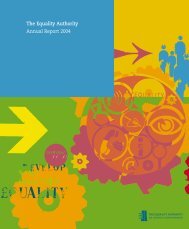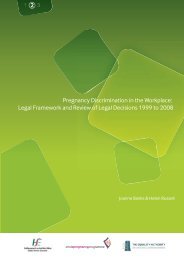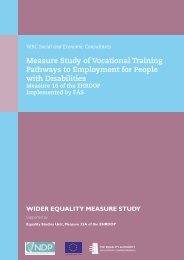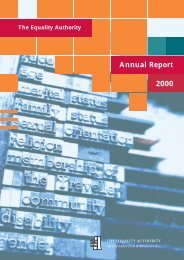Equality and Diversity - Building a Culture of ... - Equality Authority
Equality and Diversity - Building a Culture of ... - Equality Authority
Equality and Diversity - Building a Culture of ... - Equality Authority
You also want an ePaper? Increase the reach of your titles
YUMPU automatically turns print PDFs into web optimized ePapers that Google loves.
Notes on the Images <strong>and</strong> the<br />
Learning from Them<br />
These exercises help remind students that,<br />
whenever they are absolutely sure that the<br />
way they see things is right <strong>and</strong> people who<br />
disagree with them are wrong, they should<br />
stop <strong>and</strong> question whether there is another<br />
perspective that they may be missing.<br />
1. Once in a Lifetime<br />
The triangle shapes lead most people to read<br />
the phrases as ‘Once in a lifetime’, A bird in<br />
the h<strong>and</strong>’ etc. If you look carefully you will see<br />
they actually read ‘Once in a a lifetime’, Bird<br />
in the the h<strong>and</strong>’ etc. The majority <strong>of</strong> people<br />
misread these. This is because (a) the phrases<br />
are familiar, (b) we tend to read in phrases or<br />
sentences, rather than word by word (c) we<br />
tend to skip over small joining words such as<br />
a, the, if, <strong>of</strong> etc <strong>and</strong> only pay attention to the<br />
bigger words.<br />
Lessons to be learned from this exercise in<br />
relation to perceptions <strong>of</strong> diversity include:<br />
We see what we expect to see – how we have<br />
been programmed to interpret the world<br />
We don’t pay attention to small things, <strong>and</strong> so<br />
miss their significance<br />
2. The Old/Young woman<br />
You will find that some <strong>of</strong> the students have<br />
seen the old woman <strong>and</strong> some the young<br />
woman. Ask a few students to describe what<br />
they have seen <strong>and</strong> then ask for a show <strong>of</strong><br />
h<strong>and</strong>s for those who agree with one view or<br />
the other.<br />
Ask the students to look carefully again<br />
at the picture <strong>and</strong> tell them they are all<br />
correct in what they see. Some students will<br />
probably begin to see the other view, but it is<br />
likely that some will be convinced that they<br />
are right <strong>and</strong> the “other view” is wrong. Ask<br />
two <strong>of</strong> the most convinced students with<br />
opposing views to point out the woman’s<br />
nose, neck, eye etc as they see them, until all<br />
the students are able to see the two views.<br />
3. Map <strong>of</strong> Mediterranean<br />
When something is viewed in an unusual<br />
way, we fail to recognise it for what it is. The<br />
map is hard to decipher because the sea is<br />
darker than the l<strong>and</strong> – the opposite to usual<br />
practice. Additionally, the names <strong>of</strong> the<br />
countries are missing <strong>and</strong> the map includes<br />
the currents, which we wouldn’t expect to<br />
see in a common map.<br />
4. Who’s Taller? Which is longer?<br />
All <strong>of</strong> the figures <strong>and</strong> the two lines are the<br />
same size. It is the context in which they are<br />
shown which makes one look bigger than<br />
another. (In artistic terms, the perspective<br />
in the figures picture is missing – a good<br />
metaphor for how we <strong>of</strong>ten perceive things.)<br />
These remind us that before we jump to<br />
conclusions about someone's behaviour or<br />
appearance, we should try to underst<strong>and</strong> the<br />
context for that behaviour.<br />
Note: There are very many perception<br />
exercises available on the Web. You<br />
may like to find <strong>and</strong> use some <strong>of</strong> them<br />
with your students. You may also find<br />
appropriate YouTube videos which<br />
reinforce the learning for the students.<br />
SECTION 2 EXPLORING PERCEPTIONS & STEREOTYPING 29
















